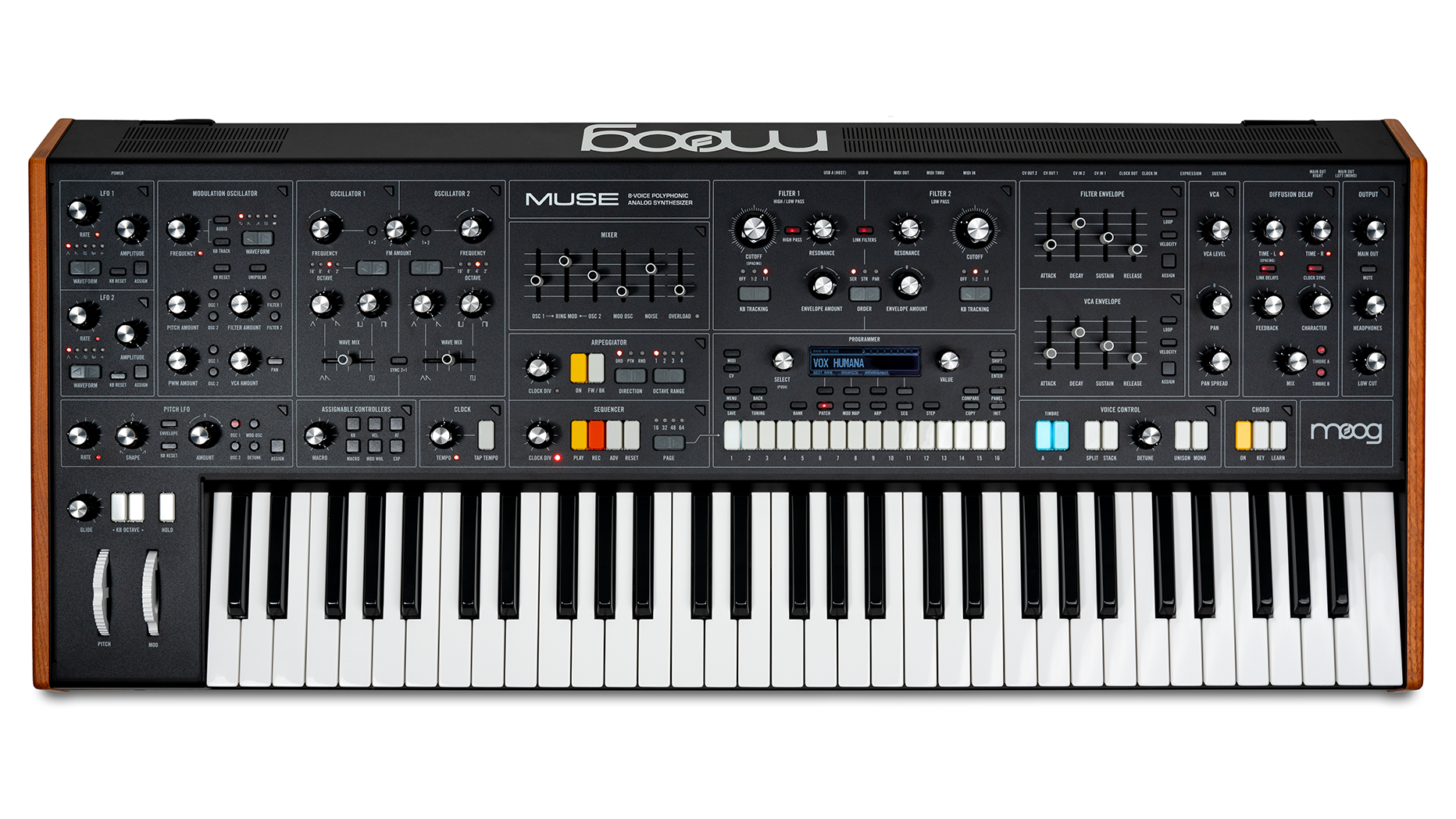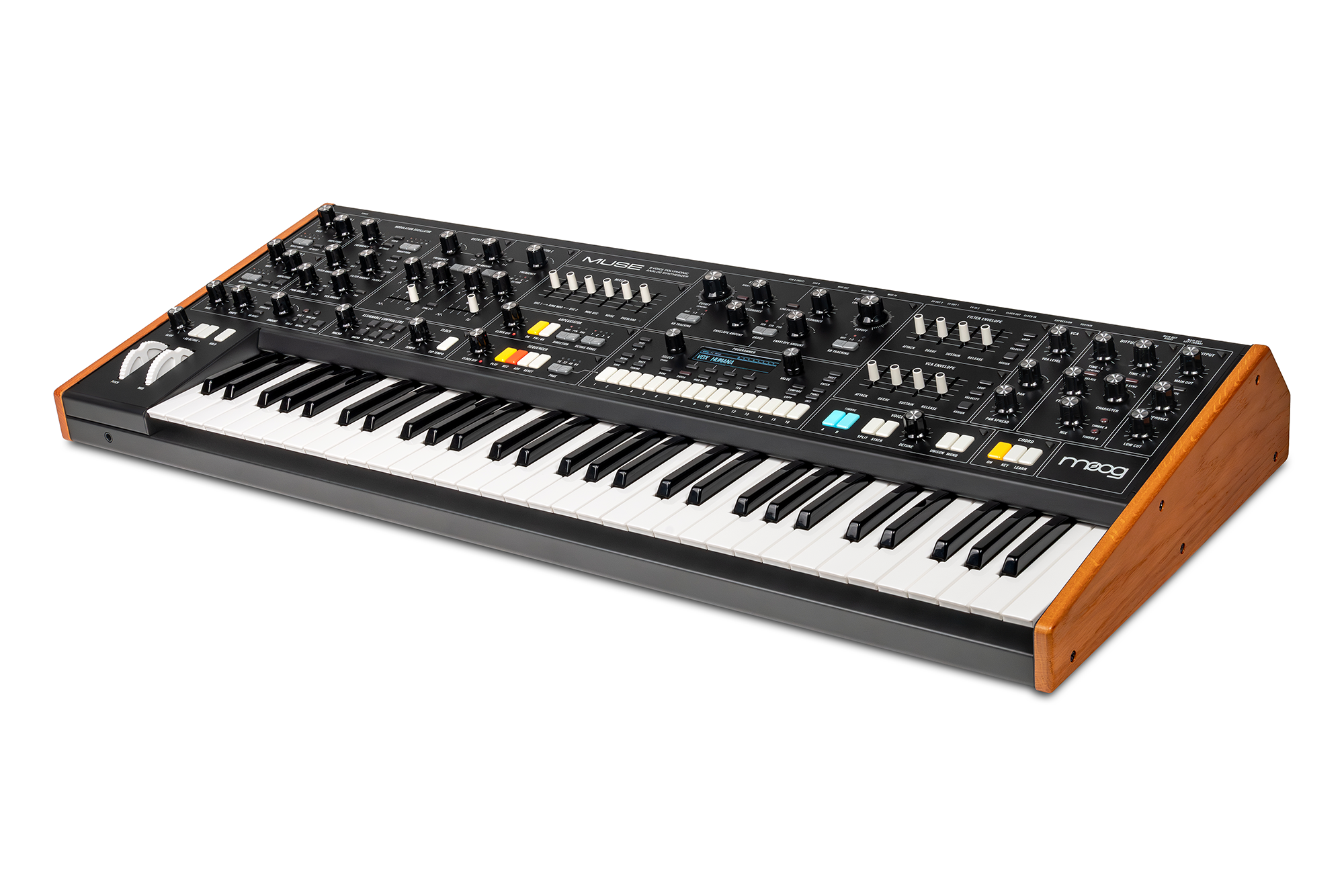
Moog has officially announced the Muse, the long-rumoured analogue synthesizer that the manufacturer has been teasing all year: we got a full list of specs from a leak earlier this month which have now been confirmed.
Muse is an eight-voice, bi-timbral synthesizer with a 61-key semi-weighted keybed, equipped with velocity and channel aftertouch. Its two analogue oscillators per voice are derived from the Moog Voyager and are capable of both FM, PWM and hard sync. These are joined by a mod oscillator with selectable waveforms that can be used to modulate the filters, pitch, PWM and VCA, along with three LFOs, one of which is dedicated to pitch modulation.
Muse's oscillators run through dual per-voice ADSR envelopes and dual analogue transistor ladder filters (one low-pass, one low and high-pass) that can be routed in series, parallel or even stereo configurations. The stereo VCAs are based on Moog Modular circuits, and offer control over volume, pan position and pan spread per voice.
That's not all; we've got a saturating mixer section with ring modulation and a digital stereo delay inspired by "vintage digital rack delays". You'll also find a 16-slot modulation matrix, a powerful arpeggiator and an even more powerful 64-step sequencer, which, much like the the recently-announced Labyrinth, offers generative and probablistic sequencing.
Muse is priced at $3499, a competitive price point that makes the instrument more affordable than analogue polysynths like the Arturia Polybrute 12, Oberheim OB-X8 and UDO Super Gemini.
Find out more on Moog's website.
Moog Muse specs
- Keybed: 61 full-size semi-weighted keys with velocity and channel aftertouch
- Controllers: Pitch Wheel, Modulation Wheel, Macro Knob, Keyboard Octave switch, Hold switch, Sustain Pedal input, Expression Pedal input – all pedal functions are assignable
- Panel Controls: 44 knobs, 16 sliders, 129 buttons – OLED screen
- Analog Voltage-Controlled Oscillators: (x2) Selectable Triangle/Sawtooth mix, variable width Pulse wave, Octave (16’, 8’, 4’, 2’), Frequency (+/- 7 Semitones), Wave Mix (blends Triangle/Sawtooth with variable Pulse wave), FM routing and amount, Hard sync
- Analog Voltage-Controlled Modulation Oscillator: Selectable waveform (Sine, Sawtooth, Reverse Sawtooth, Square, Noise), Audio range toggle switch, Keyboard tracking, Keyboard reset, Unipolar switch, Pitch Modulation routing and amount, Filter Modulation routing and amount, Pulse Width Modulation routing and amount, VCA Modulation amount, Panning switch
- Analog Voltage-Controlled Filters: (x2) Moog transistor ladder filters (1 with highpass/lowpass modes), Cutoff Frequency, Resonance, KB Tracking Amount, Envelope Amount, Linked Operation, Routing (Series, Parallel, Stereo)
- Analog Voltage-Controlled Amplifier: Volume per Timbre, Pan position per Timbre, Pan Spread per timbre
- Arpeggiator: Per-timbre with Clock Division, Octave range, Pattern, Direction, Gate time, Rhythmic programming
- Sequencer: 64 step sequencer with Clock Division, Transport controls, Sequence chaining, Step editing, Modulation capabilities, and memory capacity of 16 banks of 16 sequences
- Outputs: Main Left/Right, Headphones, CV In/Out, Clock In/Out, MIDI In/Out/Thru, USB
- Dimensions and Weight: 99 x 42 x 11 cm, 14.55 kg








